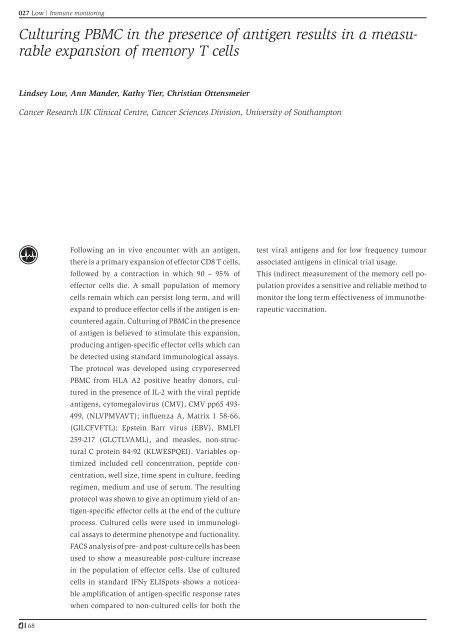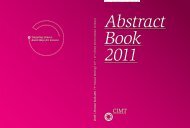Abstract Book 2010 - CIMT Annual Meeting
Abstract Book 2010 - CIMT Annual Meeting
Abstract Book 2010 - CIMT Annual Meeting
You also want an ePaper? Increase the reach of your titles
YUMPU automatically turns print PDFs into web optimized ePapers that Google loves.
027 Low | Immune monitoring<br />
Culturing PBMC in the presence of antigen results in a measurable<br />
expansion of memory T cells<br />
Lindsey Low, Ann Mander, Kathy Tier, Christian Ottensmeier<br />
Cancer Research UK Clinical Centre, Cancer Sciences Division, University of Southampton<br />
68<br />
Following an in vivo encounter with an antigen,<br />
there is a primary expansion of effector CD8 T cells,<br />
followed by a contraction in which 90 – 95% of<br />
effector cells die. A small population of memory<br />
cells remain which can persist long term, and will<br />
expand to produce effector cells if the antigen is encountered<br />
again. Culturing of PBMC in the presence<br />
of antigen is believed to stimulate this expansion,<br />
producing antigen-specific effector cells which can<br />
be detected using standard immunological assays.<br />
The protocol was developed using cryporeserved<br />
PBMC from HLA A2 positive heathy donors, cultured<br />
in the presence of IL-2 with the viral peptide<br />
antigens, cytomegalovirus (CMV), CMV pp65 493-<br />
499, (NLVPMVAVT); influenza A, Matrix 1 58-66,<br />
(GILCFVFTL); Epstein Barr virus (EBV), BMLFI<br />
259-217 (GLCTLVAML), and measles, non-structural<br />
C protein 84-92 (KLWESPQEI). Variables optimized<br />
included cell concentration, peptide concentration,<br />
well size, time spent in culture, feeding<br />
regimen, medium and use of serum. The resulting<br />
protocol was shown to give an optimum yield of antigen-specific<br />
effector cells at the end of the culture<br />
process. Cultured cells were used in immunological<br />
assays to determine phenotype and fuctionality.<br />
FACS analysis of pre- and post-culture cells has been<br />
used to show a measureable post-culture increase<br />
in the population of effector cells. Use of cultured<br />
cells in standard IFNγ ELISpots shows a noticeable<br />
amplification of antigen-specific response rates<br />
when compared to non-cultured cells for both the<br />
test viral antigens and for low frequency tumour<br />
associated antigens in clinical trial usage.<br />
This indirect measurement of the memory cell population<br />
provides a sensitive and reliable method to<br />
monitor the long term effectiveness of immunotherapeutic<br />
vaccination.



